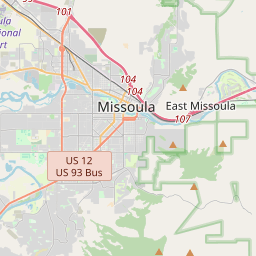Steiger Apartments
Historical marker location:
427 East Pine Street, Missoula, Montana
( Marker is on East Pine Street near Jefferson Street, on the right when traveling east.)






© OpenStreetMap contributors
This Property Contributes to the East Pine Street Historic District
Loading...
Searching for other points of interest within 3 miles of this location.In 1972, the Montana Constitution was rewritten and adopted, becoming one of the most progressive state constitutions in the United States. It includes provisions for public access to streams and rivers, protection of the environment, and guarantees of individual privacy and civil rights.
About Missoula County
Missoula County Timeline
Missoula County, located in western Montana, has a rich history that can be traced back to the indigenous peoples who called the area home for thousands of years. The Salish, Pend d'Oreille, and Nez Perce tribes were among the first inhabitants, relying on the abundance of natural resources in the region. In the early 1800s, European fur trappers and explorers began to arrive, establishing trading posts and interacting with the native communities.
The 19th century brought significant changes to Missoula County. In 1860, the town of Hellgate was founded, and it eventually became the county seat of Missoula County. With the arrival of the Northern Pacific Railroad in the 1880s, Missoula experienced rapid growth and became an essential transportation hub in the region. The timber industry boomed, attracting more settlers and facilitating the development of nearby towns.
The University of Montana, located in Missoula, was established in 1893 and has since become a respected institution, shaping the city's culture and economy. During this time, Missoula County also experienced increasing tensions with Native American tribes, leading to conflicts such as the Battle of the Big Hole in 1877. The county witnessed significant shifts in land ownership and territorial disputes throughout the late 19th and early 20th centuries.
In the 20th century, Missoula County faced challenges and transformations. The county suffered from the impacts of the Great Depression, but it also saw the construction of major infrastructure projects like the Bonner Dam and hydroelectric plant, which provided much-needed employment opportunities. Tourism started to play an essential role in the county's economy, thanks to its stunning landscapes and recreational activities. Today, Missoula County continues to thrive as a center for education, culture, outdoor recreation, and a vibrant arts scene, while still honoring and learning from its diverse history.
The 19th century brought significant changes to Missoula County. In 1860, the town of Hellgate was founded, and it eventually became the county seat of Missoula County. With the arrival of the Northern Pacific Railroad in the 1880s, Missoula experienced rapid growth and became an essential transportation hub in the region. The timber industry boomed, attracting more settlers and facilitating the development of nearby towns.
The University of Montana, located in Missoula, was established in 1893 and has since become a respected institution, shaping the city's culture and economy. During this time, Missoula County also experienced increasing tensions with Native American tribes, leading to conflicts such as the Battle of the Big Hole in 1877. The county witnessed significant shifts in land ownership and territorial disputes throughout the late 19th and early 20th centuries.
In the 20th century, Missoula County faced challenges and transformations. The county suffered from the impacts of the Great Depression, but it also saw the construction of major infrastructure projects like the Bonner Dam and hydroelectric plant, which provided much-needed employment opportunities. Tourism started to play an essential role in the county's economy, thanks to its stunning landscapes and recreational activities. Today, Missoula County continues to thrive as a center for education, culture, outdoor recreation, and a vibrant arts scene, while still honoring and learning from its diverse history.
Missoula County Timeline
This timeline provides a condensed summary of the historical journey of Missoula County, Montana.
- 1860s: Missoula County established as one of the original nine counties of Montana Territory.
- 1873: Missoula becomes the county seat.
- 1883: The Montana Central Railway reaches Missoula, leading to economic growth.
- 1895: Construction of the University of Montana begins.
- 1908: The city of Missoula is incorporated.
- 1910s: Missoula sees significant growth due to logging and the timber industry.
- 1930s: The Great Depression causes economic challenges in Missoula County and throughout the country.
- 1940s: World War II brings military presence and economic stimulation to the area.
- 1950s-1970s: Missoula County experiences growth and development, including the expansion of the University of Montana.
- 1990s-2000s: Missoula County sees continued growth and diversification of its economy, including the tech sector.